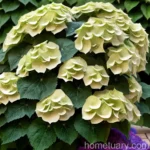The Golden Crane Hydrangea: A Complete Guide for Cultivation and Care

Hydrangeas are beloved by gardeners for their stunning and voluminous blooms, and the Golden Crane Hydrangea (Hydrangea angustipetala ‘MonLongShou’) is no exception. This exquisite variety is known for its compact size, striking golden yellow coloration, and unique lacecap flowers. In this comprehensive guide, we will delve into the key aspects of cultivating and caring for the Golden Crane Hydrangea, providing essential insights for both novice and experienced gardeners.
What is the Golden Crane Hydrangea (Hydrangea angustipetala ‘MonLongShou’)?
The Golden Crane Hydrangea, scientifically known as Hydrangea angustipetala ‘MonLongShou’, is a charming deciduous shrub that belongs to the Hydrangeaceae family. This particular variety is prized for its distinctive lacecap flowers, which feature a central cluster of tiny fertile florets surrounded by larger sterile florets. These blooming clusters can reach up to 6 inches in diameter and boast a captivating golden yellow hue, providing a stunning display in the garden or landscape.
Key Takeaways
Let’s explore the key takeaways for cultivating and caring for the Golden Crane Hydrangea, including its cultural preferences, uses, and maintenance requirements.
Culture
- Origin: The Golden Crane Hydrangea is native to East Asia, particularly Japan and South Korea, where it thrives in the cool, moist climates.
- Hardiness Zone: This variety is well-suited for cultivation in hardiness zones 5 to 9, where it can flourish in temperate conditions.
- Growth Habit: It typically exhibits a compact, mounded growth habit, reaching a mature height and spread of around 2 to 3 feet.
- Landscape Use: The Golden Crane Hydrangea is ideal for ornamental purposes, including borders, mass plantings, and mixed perennial beds.
- Flowering Season: It blooms in late spring to early summer, showcasing its stunning golden lacecap flowers.
Uses
- Ornamental Beauty: This variety is primarily cultivated for its ornamental value, adding vibrant color and visual interest to garden landscapes.
- Cut Flowers: The striking blooms of the Golden Crane Hydrangea can be used as cut flowers to create stunning floral arrangements.
Water
- Watering Needs: It prefers consistently moist, well-drained soil and benefits from regular watering, especially during periods of drought or heat stress.
- Avoid Overwatering: While it requires ample moisture, it is essential to avoid waterlogged conditions, which can lead to root rot and other issues.
Sunlight
- Light Requirements: The Golden Crane Hydrangea thrives in partial shade to full shade, particularly in regions with hot summers. Adequate shade helps preserve the vibrant coloration of its blooms and foliage.
Fertilizer
- Fertilization: Apply a balanced slow-release fertilizer in early spring to support healthy growth and abundant flowering. Avoid excessive nitrogen, as it can promote lush foliage at the expense of flower production.
Soil
- Soil Type: It thrives in well-drained, organic-rich soil with a slightly acidic to neutral pH (pH 5.5 to 7.0).
- Mulching: Apply a layer of organic mulch around the base of the plant to retain soil moisture, suppress weed growth, and insulate the roots.
Pruning
- Pruning Time: The best time for pruning is immediately after flowering, as it allows new buds to form for the following year while maintaining the overall shape and size of the shrub.
- Deadhead Spent Blooms: Remove faded flowers to promote continuous blooming and a tidy appearance.
Propagation
- Propagation Methods: The Golden Crane Hydrangea can be propagated through softwood or hardwood cuttings, division, or layering.
- Timing: Softwood cuttings are typically taken in late spring to early summer, while hardwood cuttings are collected during the dormant season.
Container Popularity
- Well-Suited for Containers: Its compact size and stunning blooms make the Golden Crane Hydrangea an excellent choice for container gardening on patios, balconies, or small outdoor spaces.
Common Diseases & Pest
Disease Diagnosis
Common pests
Botanist’s Tips
- Monitoring Moisture Levels: Regularly monitor soil moisture levels, especially during hot and dry periods, as adequate hydration is crucial for the plant’s health and flowering performance.
- Seasonal Mulching: Apply a fresh layer of mulch in late winter or early spring to provide insulation and moisture retention for the approaching growing season.
- Pruning Precision: When pruning, focus on removing old, damaged, or weak stems to encourage vigorous new growth and flower production.
Fun Facts
- The golden yellow coloration of the blooms is unique among the hydrangea varieties, making the Golden Crane Hydrangea a standout in garden landscapes.
- The lacecap flowers entice pollinators such as bees and butterflies, contributing to the overall biodiversity of the garden.
Links to External Resources
- Hydrangea Care Guide: Tips for Planting, Growing, and Pruning Hydrangeas
- Growing Hydrangeas – How to Care for Hydrangea Plants
- Hydrangeas: A Southern Plant with a Long History
- Hydrangeas Demystified: Endless Summer® Blooms in the Garden
- Hydrangea: A Gardener’s Guide
In conclusion, the Golden Crane Hydrangea (Hydrangea angustipetala ‘MonLongShou’) is a captivating addition to any garden or landscape, boasting its striking golden blooms and manageable size. By understanding its cultural preferences, uses, and maintenance requirements, gardeners can cultivate and care for this unique variety with confidence, creating a vibrant and enchanting outdoor display.
As a plant scientist, it is important to emphasize the significance of ongoing research and observation to further enhance our understanding of the Golden Crane Hydrangea and other plant species. By sharing knowledge and insights, we can collectively contribute to the preservation and appreciation of nature’s botanical wonders.















